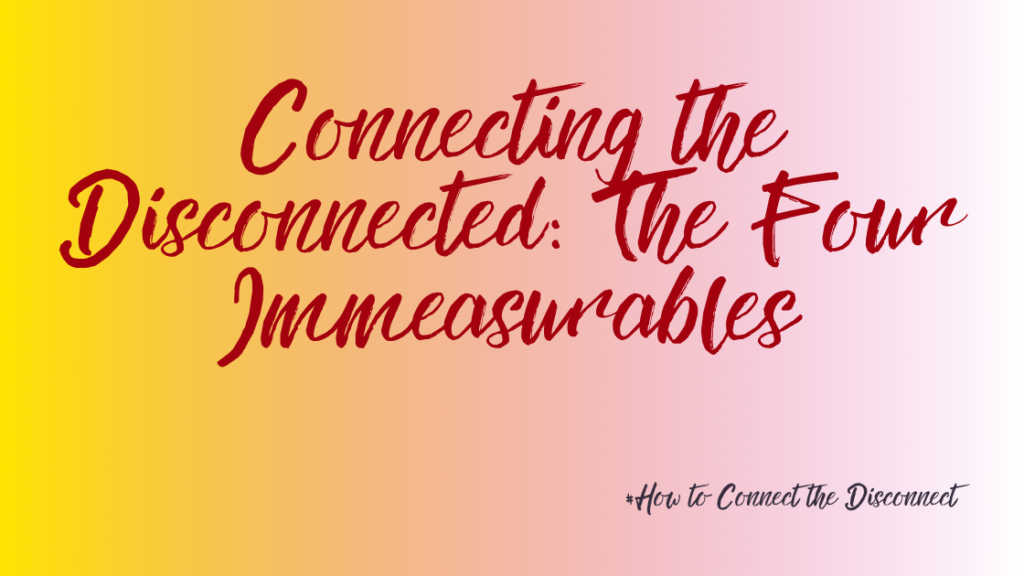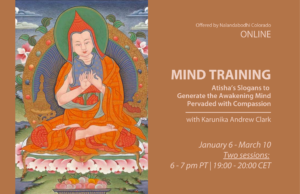Connecting the Disconnected: The Four Immeasurables
Part I
We are honored to share two articles based on Mitra Lee’s teaching at Sangha Retreat 2025. In
this first part, she offers some background and insight, which are followed by suggested practices for the immeasurable of equanimity. The second part, contains insight and practices for the other three immeasurables: love, compassion, and sympathetic joy.
The idea to talk about the four immeasurables started because I had to give a little presentation about Khadiravanītārā, and while describing her symbolism I said, “She has two arms and two legs.” This reminded me that her four limbs symbolize the four immeasurables: love, compassion, sympathetic joy, and equanimity.
Shortly thereafter, I met with a student who told me a story from a book by Matthieu Ricard called Notebooks of a Wandering Monk. When Ricard was twenty, he saw a film that had a section with faces of great Tibetan masters who had fled to India. He thought they had an “extraordinary quality,” and within a year he went to India. There he met Kangyur Rinpoche, who had the kindest face of anyone he’d ever seen, wrote Ricard. He was so struck by that kindness that he moved to the Himalayan region and has lived there ever since. Ricard says that feeling Rinpoche’s kindness has been his strength for his whole life.
And then I happened on an article by a student of Suzuki Roshi, who said that even when he was ill and dying of cancer, Suzuki Roshi seemed completely untroubled and joyous. The student wrote, “He was the embodiment of his own best teaching: Don’t stick to anything, even the truth. Each moment new.”
All of this kept reminding me of the four immeasurables. Certainly, I knew about them and appreciated the idea of them, but I hadn’t really utilized them as a practice. Unlike the four noble truths and the four reminders, which had definitely urged me to meditate and to commit to the path, the four immeasurables remained rather abstract. Of course, I wish happiness and less suffering for everybody, but there was a sort of disconnect.
I thought I would offer some practices with the intention to connect what might be disconnected. We can connect to our buddha nature with a bit more focus, and we can aspire to connect more unconditionally to a broader range of other beings. Traleg Rinpoche says in Mind at Ease, “We do the greatest service to ourselves when we concentrate on others.”
The Intention of the Four
The four immeasurables of loving kindness, compassion, sympathetic joy, and equanimity are a meditation practice from the mahayana tradition. They are a method to increase our awareness of the suffering of beings and to soften our aggression and egocentricity. They are a core foundation for the training in bodhicitta (enlightened mind).
The four are called immeasurable—or limitless or boundless—for several reasons:
- Since sentient beings are limitless, our love for them and our desire to help them must likewise be without limit.
- We perform these actions for all sentient beings freely, without any precondition.
- The immeasurables are the cause of generating unlimited accumulations of both merit and wisdom.
As you can see, the objects on which they focus (sentient beings) are boundless, the forms they take in the mind (impartial, with no qualifications) are boundless, and their results (merit and wisdom) are boundless.
Since the four qualities of the immeasurables are our nature, we should not think that this is an advanced practice. All that is necessary is that we want for others the things we want for ourselves: love, freedom from suffering, joy.
Bringing It Home
Before we can practice for others, however, we must first reconnect with ourself. Nothing can happen unless we are fully here.
Using our imagination enables us to expand our mind toward great love and great compassion, which are much more useful for bringing us into connection than are negative thinking and judgment. Kleshas, negative emotions, or depressing thoughts can really bring us down and cause despair, despondency, and disconnection. If we want to connect with ourselves and others, imagining, cultivating, and offering love and joy will be of much more benefit.
As I was pondering this topic, I realized that I’m often stopped from making a connection because I do not value a thought as anything. Is anyone helped when I think good thoughts at them? However, on the Buddhist path, the thought, while nothing, is considered more significant than the act. Nothing can happen without our thoughts. Consider our aspiration and dedication practices. We’re not actually doing anything, but we are turning our mind toward positivity.
Thus, as we practice the four immeasurables, we should remember that the meditation or contemplation is the thing itself. The practice of contemplating loving kindness, for example, is giving rise to love.
Contemplation 1
In this warm-up to our meditations on the four immeasurables, we will take a quick experiential tour of some of our most familiar and spicy emotional states.
Before we begin, I’d like to offer some words of encouragement. We’re going to be contemplating some kleshas, some unpleasant emotions, with the goals of allowing ourselves to accept them as part of our imagination and of waking up our feelings in general. So, if you find your mind avoiding or fighting this part of the practice, please try to think of it as interesting, but not a problem. If you are having difficulty, don’t despair or give up. This is why it is called “practice.”
Stay curious. After giving the problematic prompt a try, feel free to lighten up and go to a less stressful version of the feeling. Tasting each experience is enough. In time and with repetition, even the challenging emotions and the mind’s resistance will become the foundation for further progress.
Relax in the meditation posture. Breathe naturally. Put your attention on your body and how it physically feels. Focus on three things:
~ the feeling of the emotion
~ the experience of the emotion
~ the thoughts attached to the emotion
Familiarize with your kleshas through the following steps:
~ Think of someone for whom you feel aversion, and bring an image of them to mind. Not the most objectionable person, just someone who brings out a bit of that feeling. Allow several breath cycles while feeling this aversion on a physical level. Where is it in your body? Notice the thoughts that come along with that feeling. Take a deep breath and let go of the feeling and any thoughts about it.
~ Think of someone for whom you feel desire, and bring an image of them to mind. If there is nobody in your real life, fantasize. Rest in that feeling of desire on a bodily level for a minute or two. Notice whatever thoughts come along with that feeling. Take a deep breath and let go of the feeling and any thoughts about it.
~ Think of someone whom you are envious of, and bring an image of them to mind. Rest in that feeling as directly as possible as you breathe in and out for a minute or two. Feel it in your body, and notice the thoughts that arise along with that feeling. Take a deep breath and let go of the feeling and any thoughts about it.
~ Think of someone about whom you have no strong feeling, someone you usually don’t notice much. Try to bring an image of them to mind, however vague it may be. Rest for a while in the sense of indifference or not caring. Notice any thoughts that come along with it. Take a deep breath and let go of the feeling and any thoughts about it.
~ When you’ve cycled through all of these variations, come back to resting. Look around at the room where you’re sitting or look out the window. Let yourself connect with the feeling of resting.
Equanimity
Love is commonly listed first in the four immeasurables. But because of our persistent, habitual, and conditioned thoughts, our Buddhist lineage usually suggests that we begin this practice by developing equanimity or impartiality.
Traditionally, the practice for this immeasurable relies on the tender feelings we have for our own parents or children, but some of us have difficulty using these close relatives as objects of love and compassion. Even seeing them with impartiality can be difficult for many of us, so if you need to use an alternative image or example, that’s fine.
There are different ways of progressing. Some teachers suggest starting with close intimates and gradually moving outward to neutral people and then disliked individuals. Others suggest beginning with someone you feel indifferent toward and then going toward a more loved one and then to an “enemy.” In any case, we are told to proceed gradually. It is only because we take these habitual perceptions of friend and enemy as real that we accumulate negative actions through attachment and hatred.
Contemplation 2
When we rest loosely, we can feel the quality of impartiality. Since our desire is to be of benefit, we must let go of our mind’s habitual tendencies of grasping and aversion. Equanimity is having an even-minded attitude toward all beings. The problem is that we take our mere thoughts as something real; we believe those thoughts; and they turn into negative actions.
We are advised to consider how an “enemy” today might once have been a close friend, or how a past lover has become someone we now cannot stand. This is further proof that our thoughts are not real. If we are able to think beyond one lifetime, this contemplation about our changing attitudes toward relationships becomes even more powerful. Over the course of many past lifetimes, today’s so-called enemies have been dear friends who have helped us enormously. And those whom we currently consider to be our friends have been our antagonists in past lifetimes and caused us considerable harm. Relationships are constantly unstable and moving as a result of shifting circumstances.
The noble Kātyāyana, a foremost disciple of the Buddha, is quoted by Chökyi Drakpa in A Torch for the Path to Omniscience:
He eats his father’s flesh, while striking his own mother,
And cradles in his lap the enemy he killed;
The wife is gnawing at her husband’s bones.
Samsara is enough to make you laugh out loud!
Rest with this verse for a few minutes.
The usual equanimity practice is learning how to let go of our fixations toward enemies and friends and cultivating a relaxed mind. This spacious state of equanimity is said to be the most important of the four immeasurables because without it, the other three—love, compassion, and joy—can become twisted or tainted by all sorts of notions about self and other.
~ Start by bringing to mind an individual you feel close to. Think of someone you have a benevolent attitude toward. It could be your mother or father, which are the traditional examples, or it might be your child or a teacher. Anyone will do. Notice the warm feeling when you think of them. You wish them well.
~ Next, see if you can extend this feeling to those who are your so-called enemies or who cause obstacles for you. Try to wish them well.
~ Finally, consider that all friends and enemies are the same. We can wish well-being to everyone. Remember, equanimity is not indifference. We should not just think that everybody is the same without any feelings at all. We find stability by embracing the fact that everything is in motion.
~ Recite either silently or aloud: “May we dwell in the great equanimity free from passion, aggression, and prejudice.”
Please work with these two contemplations as much as you can, and in the next article, we’ll try some contemplations for the other immeasurables.
In conclusion, I’d like to share a quote from The Words of My Perfect Teacher from Patrul Rinpoche:
The image given for truly boundless impartiality is a banquet given by a great sage. When the great sages of old offered feasts they would invite everyone, high or low, powerful or weak, good or bad, exceptional or ordinary without making any distinction whatsoever. Like those great sages, our attitude toward all beings throughout space should be a vast feeling of compassion, encompassing them all equally. Train your mind until you reach such a state of boundless impartiality.

Mitra Lee Worley, professor emerita and a founding faculty member of Naropa University, became a student of Chögyam Trungpa Rinpoche in 1974. At Naropa, she developed the undergraduate program in theater studies and co-created a low-residency master’s program in contemplative education, among many other initiatives over four decades. Mitra Lee earned a master’s degree in Buddhist studies/Tibetan language through Naropa, and in 2005, Dzogchen Ponlop Rinpoche appointed her as one of Nalandabodhi’s four senior western teachers, known as mitras (from the Sanskrit word kalyanamitra, which means “spiritual friend”). Her two books, Coming from Nothing: The Sacred Art of Acting and Teaching Presence: Field Notes for Players, present topics and exercises from her contemplative performance and embodied teaching techniques. Mitra Lee currently studies and teaches within Nalandabodhi International, and she also offers workshops based on the Space Awareness teachings of Chogyam Trungpa, which she has been practicing since 1975.






